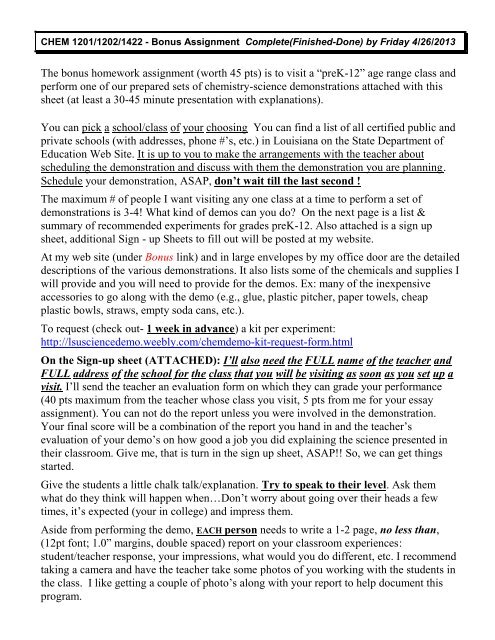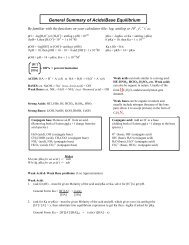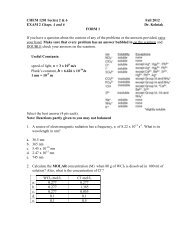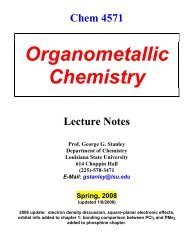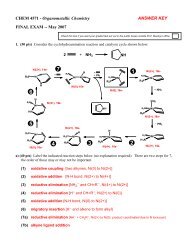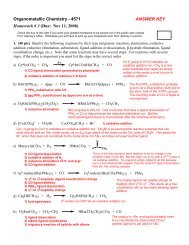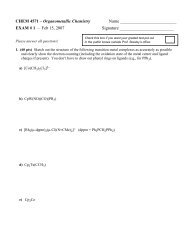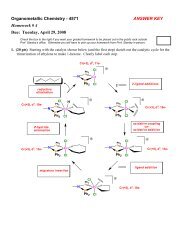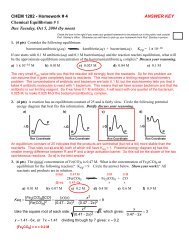CHEM 1202 - Bonus Homework Assignment - Chemistry
CHEM 1202 - Bonus Homework Assignment - Chemistry
CHEM 1202 - Bonus Homework Assignment - Chemistry
- No tags were found...
You also want an ePaper? Increase the reach of your titles
YUMPU automatically turns print PDFs into web optimized ePapers that Google loves.
<strong>CHEM</strong> 1201/<strong>1202</strong>/1422 - <strong>Bonus</strong> <strong>Assignment</strong> Complete(Finished-Done) by Friday 4/26/2013The bonus homework assignment (worth 45 pts) is to visit a “preK-12” age range class andperform one of our prepared sets of chemistry-science demonstrations attached with thissheet (at least a 30-45 minute presentation with explanations).You can pick a school/class of your choosing You can find a list of all certified public andprivate schools (with addresses, phone #’s, etc.) in Louisiana on the State Department ofEducation Web Site. It is up to you to make the arrangements with the teacher aboutscheduling the demonstration and discuss with them the demonstration you are planning.Schedule your demonstration, ASAP, don’t wait till the last second !The maximum # of people I want visiting any one class at a time to perform a set ofdemonstrations is 3-4! What kind of demos can you do? On the next page is a list &summary of recommended experiments for grades preK-12. Also attached is a sign upsheet, additional Sign - up Sheets to fill out will be posted at my website.At my web site (under <strong>Bonus</strong> link) and in large envelopes by my office door are the detaileddescriptions of the various demonstrations. It also lists some of the chemicals and supplies Iwill provide and you will need to provide for the demos. Ex: many of the inexpensiveaccessories to go along with the demo (e.g., glue, plastic pitcher, paper towels, cheapplastic bowls, straws, empty soda cans, etc.).To request (check out- 1 week in advance) a kit per experiment:http://lsusciencedemo.weebly.com/chemdemo-kit-request-form.htmlOn the Sign-up sheet (ATTACHED): I’ll also need the FULL name of the teacher andFULL address of the school for the class that you will be visiting as soon as you set up avisit. I’ll send the teacher an evaluation form on which they can grade your performance(40 pts maximum from the teacher whose class you visit, 5 pts from me for your essayassignment). You can not do the report unless you were involved in the demonstration.Your final score will be a combination of the report you hand in and the teacher’sevaluation of your demo’s on how good a job you did explaining the science presented intheir classroom. Give me, that is turn in the sign up sheet, ASAP!! So, we can get thingsstarted.Give the students a little chalk talk/explanation. Try to speak to their level. Ask themwhat do they think will happen when…Don’t worry about going over their heads a fewtimes, it’s expected (your in college) and impress them.Aside from performing the demo, EACH person needs to write a 1-2 page, no less than,(12pt font; 1.0” margins, double spaced) report on your classroom experiences:student/teacher response, your impressions, what would you do different, etc. I recommendtaking a camera and have the teacher take some photos of you working with the students inthe class. I like getting a couple of photo’s along with your report to help document thisprogram.
Recommended Demonstrations (Brief Summary’s)More detailed info can be printed out from my website under ChemDemo or outside my office on theChemDemo bulletin board.GradeK-?General Topic/DemonstrationsThe Atmosphere: Liquid Nitrogen (LN 2 ), Liquid Oxygen (LO 2 ), Solid CO 2 (dry ice), & Water VaporThis experiment involves using LN 2 to let the students “see” the major components in the air around us. LN 2has a temperature of 196ºC and freezing and shattering a flower is always impressive. Pouring LN 2 into anempty soda can causes a thin layer of liquid oxygen to form on the outside and drip off. CO 2 is one of thethings we exhale and solid CO 2 can be dropped in a container of water to make a “witches brew” effect.Having the students blow air into the LN 2 causes water vapor to condense out making “clouds”.K-3 Polymer Fun: Disappearing Styrofoam and StarchK-?When Styrofoam is added to acetone (a common organic solvent) it very rapidly dissolves, making it look like itis disappearing. Starch-based packing “peanuts”, on the other hand, will not dissolve in acetone, but do readilydissolve in water. Environmental consequences of these two properties will be discussed with the class. Themelted plastic can be recovered from the acetone to make hard solid styrofoam plastic (thus illustratingrecycling).Silly Putty: Synthesizing a PolymerAdding Elmers School glue (or generic brand School Glue) to a water/borax solution causes a chemical reactionbetween the glue molecules (polyvinylacetate) and the borax molecules (Na 2 B 4 O 7 •10H 2 O) to produce a highlyflexible, cross-linked polymer. This is similar to silly putty (real silly putty is a polymer based on organosiloxygroups and will not dry out like this material). A hands-on experiment that all students in the class will do.3-? Acids & BasesNaHCO 3 and vinegar will be used to shoot a cork out of a bottle demonstrating that some acid-base reactionsgenerate gases like CO 2 . Students in the class will participate in a voice-activated chemical reaction. Studentswill remove a stopper and speak into a flask containing base and an indicator that will change color onceenough CO 2 is introduced from the student’s breath. Further color changes from basic to acidic conditions willbe shown using a basic solution, universal indicator and solid CO 2 . Reactions of metals and acid will be shownwith Mg and Sprite.4-? Energy: Electricity, Heat & Light (<strong>1202</strong> & 1422 Only)The properties of electricity will be discussed and demonstrated with a Tesla coil and a simple generatorallowing the students to turn work into electricity. Chemical reactions to make electricity, heat and light willalso be performed. The ability to convert one form of energy into another will be discussed.5-? Light Reactions: Chemiluminesence, Flame Test, Burning Mg/CO 2Various light producing reactions will be demonstrated including chemiluminesence, inorganic flame tests,burning Mg, and finally, burning Mg in dry ice (solid CO 2 ). Chemical aspects of these will be discussed.6-12 Kinetics, Equilibrium & Catalysis (<strong>1202</strong> & 1422 Only)The rates of chemical reactions as a function of temperature will be discussed via the use of light sticks at 3different temperatures and the H 2 /O 2 balloon explosion. The concept of activation barriers to chemicalreactions will thus be introduced. The catalytic decomposition of H 2 O 2 and oscillating Iodine reaction will alsobe performed along with the chemical principles involved.
<strong>Bonus</strong> <strong>Assignment</strong> Sign-up SheetCheck Off Your Class: <strong>CHEM</strong> 1201 ____ <strong>CHEM</strong> <strong>1202</strong> ____ <strong>CHEM</strong> 1422 ____Please print CLEARLY!!!Hand in one per group!Name(s) ___________________________________________________________Demonstration: ______________________________________________________________________________________________________________________Teacher whose class you are visiting: __________________________________(first and last name!!)Teachers Email:______________________________________Grade: K 1 2 3 4 5 6 7 8 9 10 11 12School to be visited: _________________________________________________Street Address of School: ____________________________________________City: _____________________ State: ___________ Zip Code: ___________School Phone #: _____________________FAX#: _____________________Date of Visit (if known, please update when known): _________________Submit Kit Request 1 week in advance:http://lsusciencedemo.weebly.com/chemdemo-kit-request-form.html


